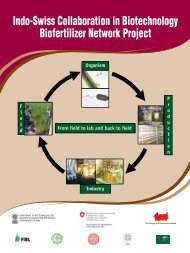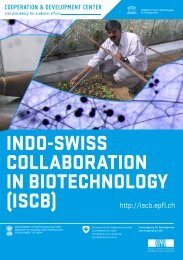BR2 - ISCB - EPFL
BR2 - ISCB - EPFL
BR2 - ISCB - EPFL
You also want an ePaper? Increase the reach of your titles
YUMPU automatically turns print PDFs into web optimized ePapers that Google loves.
In the case of 2,4-D and atrazine, highly sensitive hapten-fluorophore tracer molecules<br />
using different fluorophores (FITC/RITC) and colloidal gold particles were made for their use<br />
in fluorescence based immunoassay and dipstick applications. An on-line fluoroimmunosensor<br />
was developed for the quantification of 2,4-D and atrazine in aqueous<br />
samples. A noble hapten-protein-gold conjugate as detector molecule was also developed<br />
for dipstick applications for the detection of atrazine and 2,4-D in water. The concentration<br />
of antigen in test media was correlated with the change in intensity of the tracer signal. The<br />
dipsticks were evaluated and tested under various field conditions. The transfer of this<br />
technology to one USA company is under negotiation. Upon a request from the company, a<br />
few dipstick samples and anti-atrazine antibodies were sent for evaluation purpose.<br />
Chemiluminescence methods detected parathions with sensitivity up to sub-nanogram levels.<br />
A critical factor in this case was the stabilization of the enzyme conjugate at nanomole<br />
concentrations. Basic information on the production and immobilization of antibodies, and<br />
data on several parametric optimizations of the bioreactor column and the resulting sensor<br />
performance were generated. Several microreactors were designed and fabricated by IMT ,<br />
NE. The microreactors' chambers were designed to obtain high packing homogeneity and<br />
fluid distribution to prevent channelling effects. The final microreactor consisted in a flowthrough<br />
chamber of approx 7 µl, at the end of which 6 interleaved rows of posts were<br />
machined to retain the packing material. Prototypes were fabricated by Deep Reactive Ion<br />
Etching (DRIE) to decrease the mesh size, to allow the use of Ø 25 µm beads and to further<br />
improve the surface-to-volume ratio. The optical cell was integrated on a chip and consisted<br />
in a simple flow through cell of 0.5 µl. Good packing/unpacking properties and flow<br />
distribution were observed. Fluidic resistance was measured and was in good agreement<br />
with the theoretical model. A number of cartridge prototypes were sent to the project<br />
partners for evaluation. A generic fluid handling system was developed to interface the<br />
chemiluminescent and fluorescent assays. External pumps and valves were selected to<br />
control the incubation, the washing and the elution step. A user interface was developed<br />
under a NI Labview platform to control the fluid motion and the data acquisition. An optical<br />
system was also made to improve detection performances and robustness. This<br />
configuration was evaluated against a bench top laser-induced fluorescence confocal<br />
microscope, developed in-house. A detection limit of 0.2 ng/µL for fluorescein at pH 7.4 was<br />
achieved with a simple light-emitting device. However, following the development of the<br />
dipstick method, the microfluidic approach was suspended to better focus on the task and<br />
achieve the target in the shortest time possible.<br />
Besides the evaluation of detection methods and project coordination, investigations of<br />
antibody-antigen interaction using SPR, AFM and microcalorimetry were carried out at <strong>EPFL</strong>.<br />
IMTECH, CFTRI and <strong>EPFL</strong> jointly developed a method for the site-directed immobilization of<br />
antibodies on gold substrates for SPR applications. A freshly prepared gold surface on a<br />
glass carrier slide was modified with Protein A via a homobifunctional cross linker to achieve<br />
uniform, stable and sterically accessible antibody coating. The modified gold surface was<br />
found to be stable, repeatedly usable for several measurements and the experimental<br />
reproducibility was good.<br />
During the International Workshop on Biosensors held at CFTRI in 2003, the results of the<br />
project were discussed and biosensor kits were demonstrated to international experts. The<br />
progress of the project was well appreciated. It was felt that the results achieved so far<br />
should be seriously pursued towards the construction of an integrated biosensor device for<br />
immediate application and commercialization. In the light of the very positive results<br />
obtained; a new project is therefore planned to fabricate integrated biosensor devices in<br />
collaboration with suitable industrial partners.<br />
In brief, at the close of the project, the partners have developed biosensor methods to<br />
quantitatively detect parathions using chemiluminescent techniques up to sub-nanogram<br />
levels of contamination. It must be mentioned that an immunobioreactor-based biosensor<br />
for pesticides based on the chemiluminescence principle is being developed for the first time<br />
to detect pesticides at ppt level. The high sensitivities of detection achieved in the project<br />
promise excellent applications and exhibit very good potential for making future fieldapplicable<br />
devices. For 2,4-D and atrazine, dipstick kits are now available for a Yes/No type





